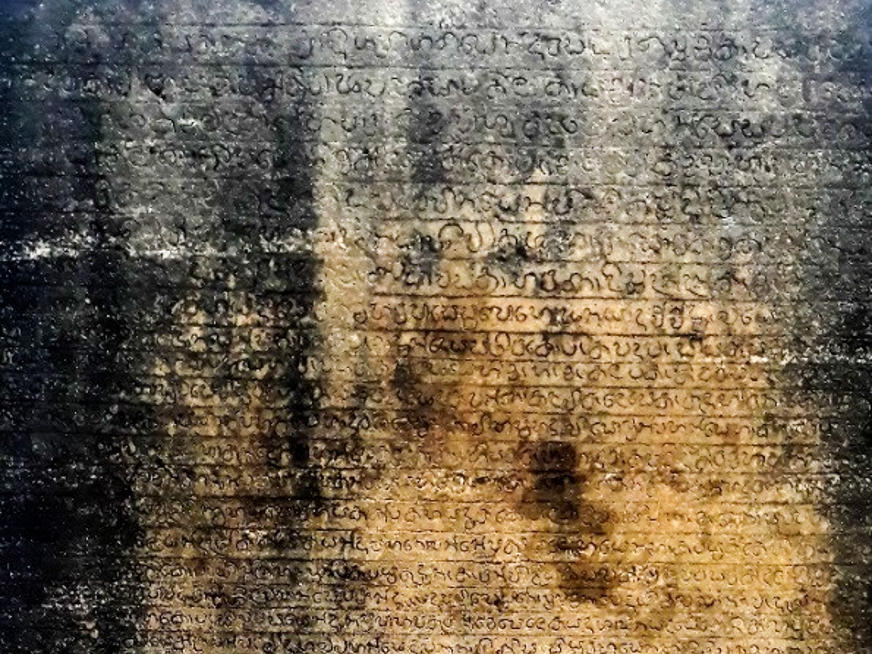Written sources as knowledge basis – Sri Lanka’s ancient chronicles and texts
The development of the Dry Zone water harvesting and management system in Sri Lanka is recorded in numerous written sources. In the framework of this project ancient records were for the first time systematically compiled, integrated in a database and analyzed. Results allow insights to be gained into the spatio-temporal development and governance of this unique water management system.
The following chronicles and epigraphic sources comprised the database for the analysis of the spatio-temporal development and the derivation of information on governance structures of the water management system in Sri Lanka. The Dipavamsa, the earliest chronicle of the island, was written by unknown authors in the middle of the 4th century CE. It contains historical narratives from the legendary beginning of the kingdoms of the island in the 6th and 5th centuries BCE to the reign of King Mahasen in 362 CE. Originally written in Pali verse, Hermann Oldenberg translated the Dipavamsa into English in 1879. The subsequent comprehensive chronicle is the Mahavamsa, “The Great Chronicle” of Sri Lanka, which was also written in Pali and translated by Wilhelm Geiger into German in 1912. The Mahavamsa is structured in two main sections: the Mahavamsa (the Great Chronicle) and the Culavamsa (the Little Chronicle).
Lithic inscriptions, available from the 3rd century BCE, provide additional information on the island’s history. From the 3rd century BCE to the 7th century CE these inscriptions were written in Brahmi script and are categorized in cave, rock, pillar and slab inscriptions. From the 8th century CE onwards most rock inscriptions were written in early Sinhalese script. The inscriptions largely address common actions such as grants of cave-dwellings, monasteries, land, tanks and villages as well as revenues from the tanks and lands. Further, they contain details on the system of government, as they served to publish rules and regulations for the management of the landscape.
Together, these ancient texts constitute a literary record of the history of Sri Lanka over a period of 2000 years. However, the analysis of these text sources requires a comprehensive investigation of the trustworthiness of the retrieved information. Classical texts in Sri Lanka written by the scholar monks generally contained stories based on historical facts and myths. Further, they are biased to the Buddhist religion and focus on the major political and ritual centres and their royal sponsors. The Mahavamsa (also: Great Chronicle) was written as a poem, resulting in many embellishments and exaggerations. However, the translator of the chronicle, Wilhelm Geiger, clearly concluded that the authors never attempted to intentionally record a falsehood, despite their religious bias. Lithic inscriptions primarily refer to common acts and predominantly provide information contemporary to the described events, untouched by the hands of editors and copyists.
All texts containing information on ancient irrigation were compiled in a database and associated to one of the following categories: 1) Tanks, ponds, dams and water holes, 2) Canals, 3) Grants of irrigation works, 4) Irrigation tax, shares and income and 5) Laws and official announcements. This collection of information built the knowledge base for the reconstruction of the spatio-temporal evolution of the tank-cascade systems and the development of governance structures.
The following examples give an overview of the analyzed texts
Tanks, ponds, dams and water holes
Then nearing Anuradhapura the king pitched his camp south of the Kasa-mountain. When he had made a tank there in the month Jetthamula he held a water festival. (Mahavamsa 25/50–51).
Canals
(…) Agriculture officers and perenattiyam [undefined profession] shall not enter; (…) the water flowing from the main canal to this village shall not be hindered; (…) (IC 5, Part 1, 94.4).
Grants of irrigation works
When the king had made the Gamanitissa-tank he bestowed it on the Abhayagiri vihara [monastery] for maintenance in food (Mahavamsa 35/120).
Irrigation tax, shares and income
Success! The water revenue and the overlord’s revenue of the tank of Nakava in Mayihina, King Naga donated to the Community of bhikkhus [monks] (IC 2, Part 1, 74)
Laws and official announcements
(…) set up four pillars at the four corners (of the Abhayavava) in order to safeguard (the said) Abhayavava, and decreed that ‘if the Nuvaraladda [the City Mayor] fails to keep a watch, arrest, (charge) and punish those who may engage in (illegal) fishing in the Abhayavava, the Madabi Officer [undefined profession], who takes care of the property of the Mahavihara, shall impose and collect a fine of ten hunas of gold from him; also, after having sent his own monastic officials, he shall confiscate the fishing nets of the culprits; and (in addition) get them to perform (free) labour at this reservoir. Those fishermen who are arrested afterwards keeping a watch at the fishing point of this reservoir (IC V, Part 1/10.5).
